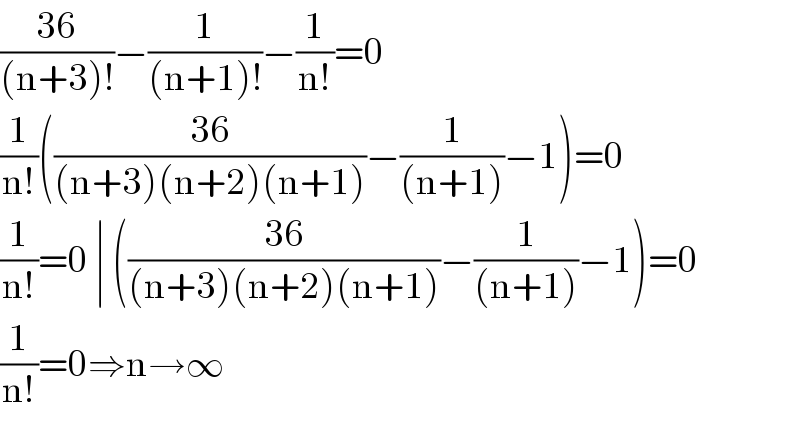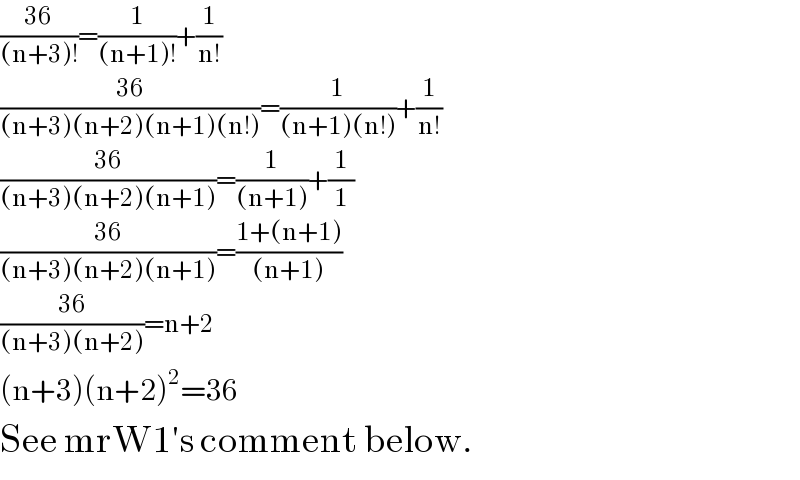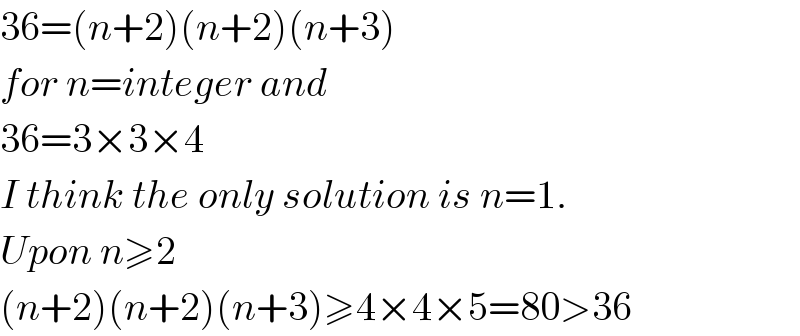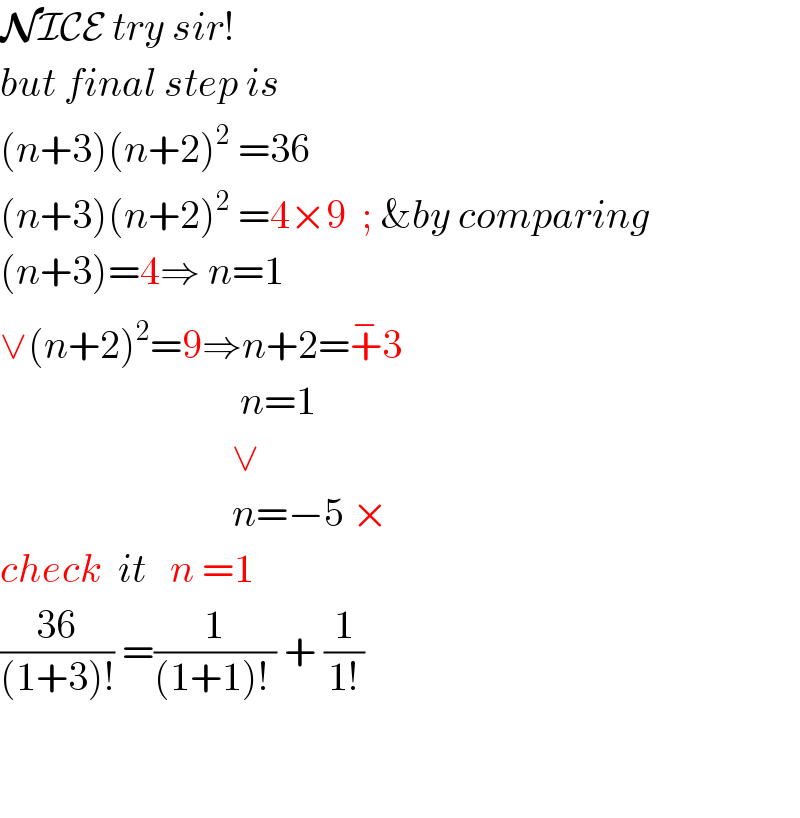Question Number 13237 by Abbas-Nahi last updated on 17/May/17

Commented by RasheedSindhi last updated on 17/May/17

$$\frac{\mathrm{36}}{\left(\mathrm{n}+\mathrm{3}\right)!}−\frac{\mathrm{1}}{\left(\mathrm{n}+\mathrm{1}\right)!}−\frac{\mathrm{1}}{\mathrm{n}!}=\mathrm{0} \\ $$$$\frac{\mathrm{1}}{\mathrm{n}!}\left(\frac{\mathrm{36}}{\left(\mathrm{n}+\mathrm{3}\right)\left(\mathrm{n}+\mathrm{2}\right)\left(\mathrm{n}+\mathrm{1}\right)}−\frac{\mathrm{1}}{\left(\mathrm{n}+\mathrm{1}\right)}−\mathrm{1}\right)=\mathrm{0} \\ $$$$\frac{\mathrm{1}}{\mathrm{n}!}=\mathrm{0}\:\mid\:\left(\frac{\mathrm{36}}{\left(\mathrm{n}+\mathrm{3}\right)\left(\mathrm{n}+\mathrm{2}\right)\left(\mathrm{n}+\mathrm{1}\right)}−\frac{\mathrm{1}}{\left(\mathrm{n}+\mathrm{1}\right)}−\mathrm{1}\right)=\mathrm{0} \\ $$$$\frac{\mathrm{1}}{\mathrm{n}!}=\mathrm{0}\Rightarrow\mathrm{n}\rightarrow\infty \\ $$
Commented by Abbas-Nahi last updated on 17/May/17

$${sorry}\:{the}\:{answer}\:{is}\:{wrong}!\:\:{n}\nRightarrow\infty \\ $$
Answered by RasheedSindhi last updated on 17/May/17

$$\frac{\mathrm{36}}{\left(\mathrm{n}+\mathrm{3}\right)!}=\frac{\mathrm{1}}{\left(\mathrm{n}+\mathrm{1}\right)!}+\frac{\mathrm{1}}{\mathrm{n}!} \\ $$$$\frac{\mathrm{36}}{\left(\mathrm{n}+\mathrm{3}\right)\left(\mathrm{n}+\mathrm{2}\right)\left(\mathrm{n}+\mathrm{1}\right)\left(\mathrm{n}!\right)}=\frac{\mathrm{1}}{\left(\mathrm{n}+\mathrm{1}\right)\left(\mathrm{n}!\right)}+\frac{\mathrm{1}}{\mathrm{n}!} \\ $$$$\frac{\mathrm{36}}{\left(\mathrm{n}+\mathrm{3}\right)\left(\mathrm{n}+\mathrm{2}\right)\left(\mathrm{n}+\mathrm{1}\right)}=\frac{\mathrm{1}}{\left(\mathrm{n}+\mathrm{1}\right)}+\frac{\mathrm{1}}{\mathrm{1}} \\ $$$$\frac{\mathrm{36}}{\left(\mathrm{n}+\mathrm{3}\right)\left(\mathrm{n}+\mathrm{2}\right)\left(\mathrm{n}+\mathrm{1}\right)}=\frac{\mathrm{1}+\left(\mathrm{n}+\mathrm{1}\right)}{\left(\mathrm{n}+\mathrm{1}\right)} \\ $$$$\frac{\mathrm{36}}{\left(\mathrm{n}+\mathrm{3}\right)\left(\mathrm{n}+\mathrm{2}\right)}=\mathrm{n}+\mathrm{2} \\ $$$$\left(\mathrm{n}+\mathrm{3}\right)\left(\mathrm{n}+\mathrm{2}\right)^{\mathrm{2}} =\mathrm{36} \\ $$$$\mathrm{See}\:\mathrm{mrW1}'\mathrm{s}\:\mathrm{comment}\:\mathrm{below}. \\ $$
Commented by mrW1 last updated on 17/May/17

$$\mathrm{36}=\left({n}+\mathrm{2}\right)\left({n}+\mathrm{2}\right)\left({n}+\mathrm{3}\right) \\ $$$${for}\:{n}={integer}\:{and} \\ $$$$\mathrm{36}=\mathrm{3}×\mathrm{3}×\mathrm{4} \\ $$$${I}\:{think}\:{the}\:{only}\:{solution}\:{is}\:{n}=\mathrm{1}. \\ $$$${Upon}\:{n}\geqslant\mathrm{2} \\ $$$$\left({n}+\mathrm{2}\right)\left({n}+\mathrm{2}\right)\left({n}+\mathrm{3}\right)\geqslant\mathrm{4}×\mathrm{4}×\mathrm{5}=\mathrm{80}>\mathrm{36} \\ $$
Commented by Abbas-Nahi last updated on 17/May/17

$$\boldsymbol{\mathcal{N}}\mathcal{ICE}\:{try}\:{sir}!\: \\ $$$${but}\:{final}\:{step}\:{is} \\ $$$$\left({n}+\mathrm{3}\right)\left({n}+\mathrm{2}\right)^{\mathrm{2}} \:=\mathrm{36} \\ $$$$\left({n}+\mathrm{3}\right)\left({n}+\mathrm{2}\right)^{\mathrm{2}} \:=\mathrm{4}×\mathrm{9}\:\:;\:\&{by}\:{comparing} \\ $$$$\left({n}+\mathrm{3}\right)=\mathrm{4}\Rightarrow\:{n}=\mathrm{1} \\ $$$$\vee\left({n}+\mathrm{2}\right)^{\mathrm{2}} =\mathrm{9}\Rightarrow{n}+\mathrm{2}=\overset{−} {+}\mathrm{3} \\ $$$$\:\:\:\:\:\:\:\:\:\:\:\:\:\:\:\:\:\:\:\:\:\:\:\:\:\:\:\:\:\:{n}=\mathrm{1}\:\:\: \\ $$$$\:\:\:\:\:\:\:\:\:\:\:\:\:\:\:\:\:\:\:\:\:\:\:\:\:\:\:\:\:\vee \\ $$$$\:\:\:\:\:\:\:\:\:\:\:\:\:\:\:\:\:\:\:\:\:\:\:\:\:\:\:\:\:{n}=−\mathrm{5}\:× \\ $$$${check}\:\:{it}\:\:\:{n}\:=\mathrm{1} \\ $$$$\frac{\mathrm{36}}{\left(\mathrm{1}+\mathrm{3}\right)!}\:=\frac{\mathrm{1}}{\left(\mathrm{1}+\mathrm{1}\right)!\:}\:+\:\frac{\mathrm{1}}{\mathrm{1}!} \\ $$$$ \\ $$$$ \\ $$
Commented by Abbas-Nahi last updated on 17/May/17

$${thank}\:{you}\:{sir}! \\ $$
